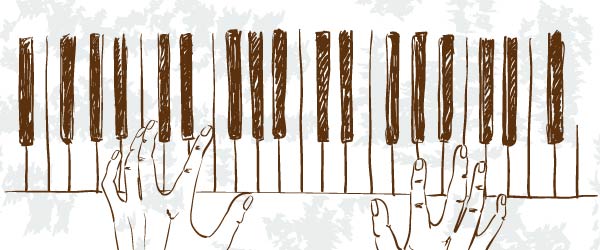For this lesson, you’ll want a copy of my free pdf with the twenty exercises I am demonstrating in the video.
What is stride piano? Stride is a jazz piano improvisational style. The name is derived from the movement of the left hand up and down the keyboard from one beat to the next. Stride is an outgrowth of Ragtime music which has its origins in African-American communities in cities such as St. Louis.
This article accompanies my YouTube video Stride Piano: Lesson One.
The first ragtime piano pieces were published in the late 1890s but the most famous was Scott Joplin’s Maple Leaf Rag, published in 1899, featuring the left-hand stride style. In later years, the stride style was borrowed and applied to popular songs from other genres, as we will do now also.
To explore the basics of the left hand stride pattern, we will start by using the C Major triad and its component parts: the notes C – E – G.
After completing the first twenty short exercises (see accompanying pdf), you should be able to play a basic left hand stride pattern in C Major along with a right hand melody.
LET’S GET STARTED
Stride Piano: Lesson One / Stride exercises on a C-Major Triad
The first five exercises are for the left hand only. We start with the simplest left-hand pattern and gradually add more complexity with each exercise.
In the second set of five exercises, we add a simple single-note melody with the right hand, and play it with each of the five left hand patterns.
Then we continue with two more sets of five exercises as we gradually add complexity to the right hand patterns. Finally, in the last exercise, we are playing the most complex of the five left-hand patterns, while playing four-note chords with the right hand.
Let’s begin!
Exercise A: This is the most basic version of a left hand stride pattern. As in all the stride patterns in this exercise, the strong beats are beats 1 and 3. The weaker beats are beats 2 and 4. Play this exercise SLOWLY and slightly staccato. Fingerings are provided in the pdf for all the exercises.
Exercise B: Building on the first pattern, we increase the complexity slightly, playing the same pattern as exercise A except that for beats 2 and 4 we now play an interval, E and G, instead of a single note.
Exercise C: Same as exercise B except the #5 finger (pinky) plays the single notes on beats 1 and 3 and fingers 1, 2, and 3 play a first inversion C Major triad with C4 (middle C) being at the top of the chord stack. This is the first exercise where the left hand is beginning to “stride” back and forth across the piano keyboard, due to the increased distance between the beats.
Exercise D: Now the strong beats are being played as octaves while the weak beats are the same as exercise C.
Exercise E: Same as before except on beat 3 we play one octave lower than in exercise D, increasing the distance of the “stride.” This is the widest distance traveled between a strong beat and weak beat in this exercise.
You’ve now learned all five of the left-hand patterns for lesson one. The rest of the exercises in lesson one repeat these patterns with the left hand while gradually adding new patterns with the right hand.
Work on these five left-hand patterns until you are ready to add a single-note melody with your right hand.
Exercises F-J: In these five exercises, the left hand will toggle through the five previous stride patterns while the right hand plays a simple one-note melody on top of them.
Exercises K-O: Same as exercises F-J except that the right hand plays the melody as octaves.
Exercises P-T: The last five exercises in lesson one are the same as exercises K-O except that now we are inserting two inner notes between the melody octave notes. Notice that ALL inner notes come from a C Major triad (C-E-G).
This completes Lesson One of the Stride Piano Course. In the next lesson we will start working with more chords and variations of the left hand pattern.



Great lesson, fine musician!!
Thanks Claudio,
Jeff
jefさんこんにちは。
全くの初心者で半年ほど前から自己流で弾いている65歳の男です。
My Blue Heaven 素晴らしいです。
一生かけても弾きたいと思っています。
(My Blue Heaven: Stride Piano Style verygood veryfine)
この楽譜を入手したいのですがどのようにすれば良いのでしょうか?
一度メールをしましたが連絡がなく再度御連絡した次第です。
あまり?にも古いので連絡がとれないのでしょうか?
是非御連絡をお願いします。
Iwant sheetmusic ”My Blue Heaven: Stride Piano Style”
I’m sorry Toru Koutani,
I improvised that piece and don’t have sheet music.
cheers,
Jeff
Great lesson
Thanks Mary Lee,
Jeff
I enjoyed the lesson and looking forward to the next lesson.
Great installation